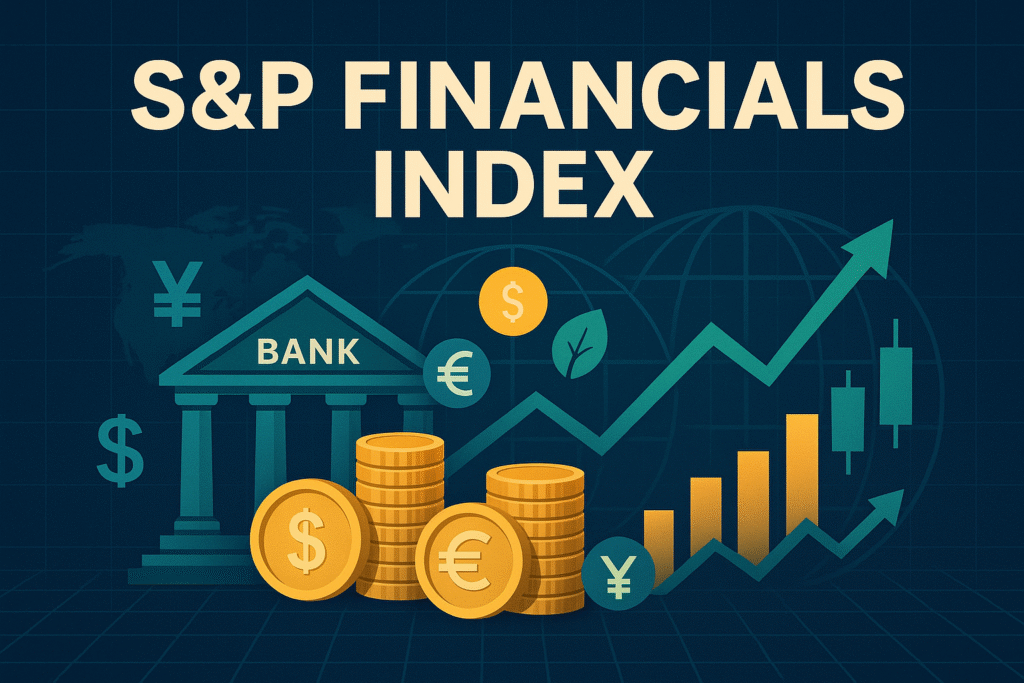A sector slice of the S&P 500 that captures U.S. banks, insurers, asset managers and credit‑card networks, the S&P 500 Financials Index (ticker S5FINL) lets investors track—and, if desired, trade—the collective fortunes of Wall Street in a single number.

1. Snapshot (May 2025)
To begin with, consider the headline statistics:
| Metric | Value |
|---|---|
| Constituents | ≈ 68 stocks |
| Float‑Adjusted Market Cap | US $4.9 trillion |
| Index Weight in S&P 500 | 12.8 % |
| Dividend Yield | 1.9 % |
| Top Holdings | JPM 11 %, BAC 8 %, WFC 5 %, V 5 %, MA 4 % |
Although mega‑caps lead, equal‑weighted and capped versions are also published for diversification.
2. How the Index Is Built
First and foremost, a company must sit inside the S&P 500 and carry a GICS “Financials” sector code—covering banks, diversified financials, insurance and consumer‑finance firms. Next, each name is float‑adjusted market‑cap weighted; consequently, giants like JPMorgan move the gauge more than regional lenders. Moreover, quarterly rebalances (March, June, September, December) realign weights and handle corporate actions automatically.
3. Industry Sub‑Mix
Furthermore, the sector splits into four primary groups:
| Sub‑Industry | Approx. Share* |
|---|---|
| Banks | 39 % |
| Financial Services (incl. V, MA, PYPL) | 28 % |
| Insurance | 24 % |
| Capital Markets & Asset Managers | 9 % |
*Float‑adjusted weights, April 2025. Therefore, payments stocks cushion rate‑cycle swings typical for banks.
4. Recent Performance (Total Return, USD)
| Year | % Return | Key Driver |
|---|---|---|
| 2022 | –10.9 % | Curve inversion, recession fears |
| 2023 | +11.8 % | Stabilising deposits, cost cuts |
| 2024 | +20.5 % | Fed rate cuts steepen curve |
| YTD 2025 | +6.3 % | Loan growth and fee income recovery |
Thus, three‑year annualised volatility sits near 18 %, slightly above the broad S&P 500.
5. Why Investors Track It
- Sector Beta: One ETF trade—think XLF—provides diversified exposure to U.S. financials.
- Macro Gauge: Index moves mirror yield‑curve shifts, credit trends and consumer spending.
- Benchmarking: Active financial‑sector funds measure excess return relative to this yard‑stick.
- Derivative Liquidity: Cboe options and CME futures enable tactical hedges when policy surprises hit.
6. Strengths & Caveats
| Strengths | Caveats |
|---|---|
| Transparent, rules‑based, long history | Mega‑cap dominance (JPM + BAC ≈ 19 %) |
| Quarterly reviews keep roster fresh | No pure‑play fintech micro‑caps—only S&P 500 members |
| Deep ETF and options market | High correlation to U.S. monetary policy swings |
7. Themes to Watch
Moreover, several trends could sway returns:
- Basel III Endgame: Forthcoming capital rules may limit big‑bank buybacks, yet raise margins for regional lenders.
- Payments Innovation: Tokenised settlements and FedNow adoption could expand fee pools for networks like Visa and Mastercard.
- Wealth Management Boom: Aging demographics bolster asset‑manager inflows, possibly lifting the capital‑markets sleeve.
- Credit Quality: Consumer delinquencies remain below trend, but watch CRE office exposure for stress signals.
Key Takeaways
In summary, the S&P Financials Index bundles nearly 70 S&P 500 names into a single, float‑weighted gauge that faithfully tracks U.S. banking, insurance and payments momentum. Its 1.9 % dividend yield, moderate volatility and tight correlation with rate cycles make it a vital tool for sector rotation, macro hedging and performance benchmarking alike.